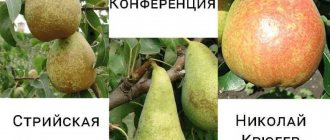Types and varieties of rowan
Rowan is a low woody plant from the Rosaceae family. The leaves are large, odd-pinnate, with oblong leaflets (their number ranges from 10 to 23). The flowers are white, numerous, collected in dense inflorescences, and have a strong scent. The fruits are bright (scarlet, orange, red), small, with a characteristic bitterness.
Rowan, familiar from childhood, grows almost throughout Russia.
In addition to the red rowan (Sorbus), there is also the chokeberry (Aronia), which is a plant belonging to a different genus. They are very distant relatives. The name arose due to the similarity of the fruits.
There are many types of rowan, the most famous of which is the common rowan. Found naturally in the temperate climate of Eurasia. The fruits are orange or scarlet, the leaves are imparipinnate. It is divided into two varieties: Moravian and Nevezhinskaya. Almost all modern varieties originated from them.
Burka
Burka is characterized by a compact crown and short stature. The maximum height of the tree is 3 m. The plant quickly begins to bear fruit; gardeners can harvest the first harvest of berries already in the 2nd–3rd year. One tree can bear 35–40 kg of fruit. Usually medium, less often large, berries with a red-brown tint have dense pulp with a sweet and sour taste. The berries can be stored for up to 4 months.
Rowan Burka begins to bear fruit in the 2nd–3rd year
Michurinskaya dessert
A distinctive feature of the Michurinskaya dessert rowan is its early ripening (in the last ten days of July - the first ten days of August), which is two weeks earlier than usual. The tree bears fruit every year and the harvest is plentiful. Large berries from dark red to brown shades are similar to medlar. The sweet and sour taste is characterized by the piquant tartness of rowan. The sugar content is considerable - up to 11%. This sweet-fruited rowan needs quick harvesting; even if the fruits are slightly overripe, they lose their attractiveness and presentation. The best storage method is drying. The berries become like sweet raisins. Michurin dessert rowan is not susceptible to pests and copes well with diseases.
Berries of the Michurinskaya dessert rowan ripen in the last ten days of July - the first ten days of August
Grenade
Pomegranate rowan is the result of crossing the common rowan with hawthorn. The tree reaches a height of 4 m and has an openwork crown. It usually begins to bear fruit in the 3rd year. From one plant you can collect up to 50 kg of tasty fruits. The medium-sized berries have a peculiar faceted shape. When ripe, the dark red fruits become covered with a bluish coating. There is not enough sugar in the berries, only 5–8%, so the taste is sweet and sour, rowan. This variety is good for making jam and making wine. Many people prefer to freeze ripe berries. The variety is resistant to many diseases and pests.
Pomegranate rowan is the result of crossing rowan with hawthorn.
Liquor
A hybrid of the common mountain ash and chokeberry gave birth to the Lickernaya mountain ash. The peculiarity of the variety is its frost resistance. The tree is medium-sized (up to 5 m), produces the first harvest in the 3rd–4th year. The berries become almost black when ripe. Their sugar content is quite high, approximately 9.6%. The berries have a sweet and sour taste and are most often used fresh, although they are also suitable for processing.
The fruits of the rowan liqueur can be eaten fresh.
Scarlet large
Large scarlet rowan received its name for the color of the fruits and their size (more than 2 g). The tree reaches a height of 6 m. The crown of the rowan tree is spreading, wide-pyramidal in shape. The leaves are large, compound, odd-pinnate. In summer they are shiny, dark green in color. The hybrid is frost-resistant and can withstand winters with temperatures down to -50°C without loss.
Large Scarlet mountain ash tolerates severe frosts
Kashmiri
The tree of this winter-hardy variety grows up to 4 m in height. Its homeland is the Himalayas, the variety has proven itself well in the Leningrad region. The berries are white, arranged in large, heavy clusters. The diameter of one berry reaches 10–12 mm. The green, imparipinnate leaves turn yellow-orange in autumn.
Cashmere rowan produces unusual white berries
Titanium
The Titan variety is created from mountain ash in combination with red-leaved apple and pear. This hybrid has proven itself among Russian gardeners, as it has shown high resistance to adverse natural conditions. Fruiting occurs already in the second season after planting. The berries are quite large, reaching 2 g. When ripe, the dark cherry-colored fruits are covered with a bluish coating. The pulp of the berries is bright yellow with a sweet and sour taste. After drying, the berries become similar to the usual raisins.
Rowan variety Titan is resistant to adverse natural conditions
Gorgeous
The Beauty variety was the result of crossing a pear with a mountain ash. The tree is medium-sized (up to 5 m), with a pyramidal, slender crown. Large berries (more than 10 mm in diameter) of yellow color ripen on Krasavitsa. The fruits have a pleasant sweet-sour taste, therefore suitable for both fresh consumption and storage. The hybrid is frost-resistant and undemanding to the soil.
Rowan berries Krasavitsa - quite large, yellow in color
Rowan is crossed with plants of other species. As a result, the hybrids Sorbania (rowanberry and chokeberry), Sorbapyrus (rowanberry and pear), Amelosorbus (rowanberry and serviceberry), Krategosorbuz (rowanberry and hawthorn), Malosorbus (rowanberry and apple tree) were obtained.
Application in landscape design
Rowan with white fruits is grown primarily because of its high decorative qualities.
It is used in landscape design:
- as a “solo” plant in a single planting;
- for creating alleys, large and small plant groups;
- in combination with other types and varieties of rowan with red and yellow fruits;
- in compositions with coniferous and deciduous trees, bushes of viburnum, spirea, barberry, honeysuckle, wrinkled rose;
- as a background for flowering herbaceous perennials;
- in the background in flower mixborders in the company of hosta, saxifrage, fescue, bergenia, tenacious.
Advice! Decorative plantings of white rowan look very nice, “neighboring” with large and small stones.
The clusters look incredibly beautiful in the fall against the backdrop of crimson foliage.
Planting rowan
Many varieties of mountain ash tolerate transplantation well and take root quickly in a new location. To obtain this result, you need to follow a few simple rules.
- September is ideal for planting and transplanting rowan seedlings.
- A tree requires a hole measuring at least 60x60 cm.
- To fill the hole, use a mixture of rotted manure with peat compost and topsoil. You can add 100–200 g of ash and superphosphate.
- Before planting, it is better to dip the roots into a clay mixture, then place them on a mound made in the middle of the hole and straighten them. The root collar of the plant should be located at ground level.
- The plant must be watered thoroughly (2-3 buckets per hole). It is necessary to water each layer of soil, then no voids will form under the roots of the seedling.
- The planted tree must be tied to a stake, and ideally to three tied sticks inclined towards the tree. This will create a protective frame for the seedling.
It is a mistake to trample the soil with your feet after planting. This leads to severe soil compaction and impairs the functioning of microorganisms.
Rowan is a tall tree, so it is worth ensuring that it does not shade other plantings. To obtain a higher yield of berries, it is necessary to plant several varieties of rowan on the site. The trees are located 5–6 m from each other.
Transplanting rowan to a new place
You can replant rowan according to its planting scheme. The only thing that needs to be taken into account is deep digging of the root system. If you have the skill of grafting plants, it is quite possible to dig up a wild mountain ash in the forest and transfer it to the garden. After complete rooting (usually next year), several cuttings of different varieties should be grafted onto the wildflower.
Rowan propagation
To grow rowan, it is customary to use two methods: vegetative and seed. Species rowan usually reproduces by seeds. Preparing seeds for sowing occurs in the fall.
- Ripe berries are selected, the seeds are removed from them, the pulp is thoroughly washed and dried.
Rowan seeds need to be cleared of pulp and dried.
- Then the seeds are sown in the ground to a depth of 10 cm and mulched with fallen leaves. You can sow seeds in spring. It is important not to forget to start preparing them for sowing in advance.
- The preparation procedure is carried out as follows: rowan seeds are mixed with coarse sand in a ratio of 1:3.
- The resulting mixture is kept for 6–8 weeks at room temperature.
- For the next 2–4 months, the seeds and sand are stored in the refrigerator, placed in a vegetable drawer.
- Sowing is done after the snow melts. You can sow seeds in a greenhouse or special boxes. Until autumn, the seedlings remain in one place, they are watered, periodically weeded, and the soil is loosened. In the fall, the seedlings are transplanted into a mini-bed (the so-called shkolka).
- Seedlings obtained from seeds begin to produce crops in the 4th–5th year.
Valuable rowan varieties are usually propagated vegetatively. For this purpose, grafting, shoots or layering, green or lignified cuttings are used. A traditional rootstock for grafting can be a rowan tree. Budding (grafting) is carried out in April, when sap flow begins. If the spring deadlines are missed, then budding can be carried out in late July - early August. The bandage is removed from the vaccination site after 20–25 days.
Beneficial features
Rowan fruits have been used for treatment for thousands of years. In ancient Roman times, they were prescribed to strengthen the stomach. In folk medicine, an infusion of berries is taken as a hemostatic (strengthens capillaries), gastric and diuretic. In addition, a decoction of rowan bark is used for high blood pressure, and dried flowers are used for colds.
A large number of useful substances were found in fully ripened berries. These include organic acids (succinic, citric, malic and others), ascorbic acid, flavonoids, amino acids, vitamins, tannins and pectins.
Growing rowan
To grow rowan in the garden, you need to perform the usual operations when caring for fruit trees.
Watering
It is necessary to water rowan immediately after planting in a permanent place, as well as at the beginning of the growing season or during a period of prolonged absence of precipitation. It is advisable to provide additional moisture 10–15 days before harvesting, as well as 10–15 days after harvesting. Each tree requires up to 3 buckets of water.
Recent Entries
Lilac perennials that are beautiful, compact and do not crowd out other plants Why when buying seedlings you should not take the sellers’ word for it and how to determine the age of the plant using 3 signs Tomato seedlings have turned purple or whitish: why the color has changed and how to save the plants
You need to water in the grooves around the tree trunk, and not directly under the root.
Loosening
Loosening the soil around the mountain ash is carried out several times during the spring-summer season. The first time to loosen the soil is in early spring. In summer, loosening is carried out 2–3 times. It is best to produce it on the second day after rain or watering. Afterwards, the soil around the trunk is mulched with organic matter.
Fertilizer application
In the 3rd year of life, the rowan tree needs the first feeding, which is carried out in early spring. You need 5–7 kg of humus or compost and 50 g of ammonium nitrate (per tree). The best time for the next feeding is the beginning of June. Rowan is watered with mullein solution (in a ratio of 1:5), you can use bird droppings (in a ratio of 1:10). 10 liters of solution per tree will be enough. Instead of organic matter, you can use Agrolife fertilizer. In August-early September the last feeding is carried out. This will require 2 tbsp. wood ash and 0.5 tbsp. superphosphate.
Rowan pruning
In the 2nd year of life, the tree needs to undergo the first pruning to avoid thickening of the crown and create a strong skeleton. When forming a pyramidal crown, it is important to consider that shoots growing at right angles to the main trunk are initially removed. Next are branches growing at an acute angle, since they lack strength. Therefore, the gardener should try to preserve the skeletal branches of those that grow at an obtuse angle.
You shouldn’t get too carried away with pruning; it can do more harm than good. If the bark of the trunk and main skeletal branches is pruned too often, it can be so exposed that there is a risk of sunburn.
Tree pruning is divided into three types:
- sanitary pruning (as necessary, when you need to remove broken, dried or diseased branches);
- rejuvenating pruning is required to restore the strength of the tree. The need for it appears if the plant growth does not exceed 10–12 cm per year, but the yield remains high. It is carried out in two steps: in the first year, 50% of the branches are pruned, and the same amount will remain for the next year. Strong anti-aging pruning is needed when there is no growth or it is no more than 5 cm per year, and the yield is also reduced. It consists of rejuvenating skeletal (semi-skeletal) branches into wood every 6–7 years. At the same time, mineral feeding of the tree is necessary;
- growth restriction pruning is needed to coordinate the height of the tree. It is carried out in the 8th–10th year of the rowan tree’s life, and is especially relevant for varieties of the so-called “folk” selection. As a result of pruning, the central sprout is removed, replacing it with any branch from the upper tier.
Rowan needs annual pruning
Pruning rowan in spring
It is best to prune rowan while the buds have not yet swelled, that is, in early spring. Each wound exceeding 3 cm in diameter must be treated with garden varnish. Covering the wound will protect the rowan from infection with diseases, prevent drying out and accelerate the formation of callus.
Pruning a mature tree in early spring involves thinning the middle of the tree's crown, as well as directing the central conductor to a side branch. In addition, be sure to remove damaged and dry branches.
A young tree should not be heavily pruned, because this leads to the development of shoots and, accordingly, to a decrease in yield.
Video: pruning rowan
Description of culture
On thin brown branches, green elongated leaves with a pointed end (length from 4 to 6-7 cm, width 1-1.5 cm) and small denticles are arranged alternately. White small flowers about 1 cm wide bloom in a complex inflorescence of the corymb type. Its diameter reaches 18-19 cm. In one inflorescence the number of flowers can exceed 120-130 pieces.
The width of the roundish or slightly flattened red, orange or yellow fruits varies from 9 to 12-13 mm. Tart and bitter fruits of rowan are harvested only after frost.
Diseases and pests of rowan
Despite the fact that rowan is susceptible to almost all diseases and pests of fruit trees, it shows enviable resistance. Birds can greatly harm a mature rowan crop.
Experienced gardeners claim that no diseases will appear on a healthy seedling with proper care. Diseases appear only in weakened plants.
There are some types of diseases that cannot be cured: any type of necrosis, some types of mosaic. It is better to prevent them using preventive measures. Prevention of diseases fatal to mountain ash consists of a thorough examination of seedlings, proper planting of the tree and proper care for it. Virus-carrying insects that appear from time to time must be mercilessly destroyed.
Table: preparations for controlling rowan pests
| Rowan pest | A drug to destroy it |
| Weevil | Karbafos |
| Bark beetles | Aktar, Konfidor, Lepidotsid |
| Moths | Chlorophos, Cyanix, Karbafos |
| Rowan gall mites | Colloidal sulfur |
| Rowan moth | Chlorophos |
| Green apple aphid | Aktellik, Decis |
| Shchitovka | 30 plus |
Preventative treatment against pests is used. In early spring, it’s a good idea to add Nitrafen to the soil under rowan trees, and also treat the tree itself with it. Before the sap begins to flow, you can spray the rowan tree with a solution of copper sulfate (100 g per 10 liters of water).
A well-proven method of protecting rowan leaves with an infusion of white mustard. To do this, you need to pour 10 g of mustard powder into 1 liter of water and leave for 24 hours. For the finished solution, you need to dilute the resulting mixture with water in a ratio of 1:5.











